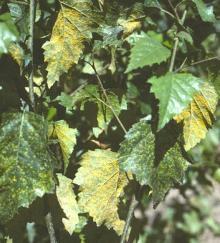Cause Melampsoridium betulinum, a fungus. The alternate stage of the fungus causes a blister rust on larch. Both urediniospores on bud scales and teliospores on fallen leaves can overwinter and serve as a source of inoculum in the spring. Cool, wet weather favors disease development. In Oregon, the disease has been a problem principally in nurseries.
Symptoms Small, yellow, angular spots develop on leaves. Bright reddish yellow pustules (uredinia) form on undersides of leaves. Later in summer, pustules turn brown to almost black (telia). Severe infection will cause defoliation.
Cultural control Remove and destroy fallen leaves in the fall.
Chemical control Use before symptoms are expected to develop.
- Armada 50 WDG at 3 to 9 oz/100 gal water. Do not use a silicone-based surfactant. Not for nursery or greenhouse use. Group 3 + 11 fungicide. 12-hr reentry.
- Compass 50 WDG at 2 to 4 oz/100 gal water. Do not use organosilicate additives. Group 11 fungicide. 12-hr reentry.
- Eagle 20 EW at 6 to 12 fl oz/100 gal water. Group 3 fungicide. 24-hr reentry.
- Heritage at 1 to 4 oz/100 gal water plus a non-silicone-based wetter sticker. Group 11 fungicide. 4-hr reentry.
- Myclobutanil 20 EW T&O at 6 to 12 fl oz/100 gal water plus spreading agent. May observe a PGR effect. Group 3 fungicide. 24-hr reentry.
- Myclotect at 6 to 12 fl oz/100 gal water plus spreading agent. May observe a PGR effect. Group 3 fungicide. 24-hr reentry.
- Spectracide Immunox Multi-Purpose Fungicide Spray Concentrate for Gardens at 1 fl oz/gal water. Group 3 fungicide. H
- Tourney EZ at 1 to 4 oz/100 gal water. Group 3 fungicide. 12-hr reentry.
References Ziller, W.G. 1974. The Tree Rusts of Western Canada. Canadian Forestry Service. Publication 1329.
Dooley, H.L. 1984. Temperature effects on germination of uredospores of Melampsoridium betulinum and on rust development. Plant disease 68:686-688.


